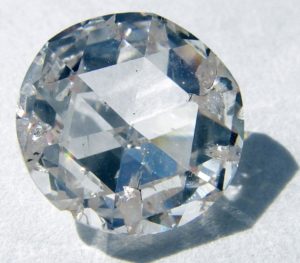James Conca CONTRIBUTOR – I write about nuclear, energy and the environment
Such a battery produces very low power, but has no moving parts, no emissions of any type including radiation, needs no maintenance, does not need to be recharged and will operate for thousands of years.
The team grew a man-made diamond that, when placed in a radiation field, was able to generate a small electrical current. And the radioactive field can be produced by the diamond itself by making the diamond from radioactive carbon-14 extracted from nuclear waste.
Even better, the amount of radioactivity in each diamond battery is a lot less than in a single banana.
(Bananas are slightly radioactive because they contain potassium and potassium decays) Technocracy’s addition.

Diamonds are made from pure carbon subjected to high pressures, usually deep in the Earth’s crust. But we have been artificially making them for decades. You just need a good carbon source, such as graphite or coal, and a machine to create the high pressure.
It turns out that we use graphite blocks to moderate nuclear reactions in many nuclear power plants. The neutron radiation during operations activates the non-radioactive carbon by capturing a neutron and producing radioactive carbon-14, mostly at the surface of these blocks. Research by another group at Bristol showed that it is possible to extract most of the carbon-14 from the graphite so it can be made into a diamond, thereby becoming a nuclear-powered battery.
The normal way to produce electricity is to use energy, like burning coal or capturing wind, to move a magnet through a coil of wire to generate a current. However, a diamond is able to produce a charge simply by being subjected to a radiation field.
Professor Tom Scott from Bristol’s Cabot Institute points out, “There are no moving parts involved, no emissions generated and no maintenance required, just direct electricity generation. By encapsulating radioactive material inside diamonds, we turn a long-term problem of nuclear waste into a nuclear-powered battery and a long-term supply of clean energy.”
There are a million tons of such graphite blocks around the world and this would be a great use for them, a use that would reduce their radioactivity and the cost to dispose of them. The cost to produce a diamond is a lot less than disposing of nuclear waste.

Dr. Neil Fox from Bristol’s School of Chemistry further explained that carbon-14 was chosen as a source material because it emits a short-range radiation (a beta particle which is essentially the nucleus’ version of an electron), that is quickly absorbed by any solid material. Held within a diamond, such short-range radiation cannot escape, especially since we put a thin layer of non-radioactive diamond on the outside. Since diamond is the hardest substance known to humans, there is literally nothing we could use that could offer more protection.
These radioactive diamond batteries would have a very specific purpose – low power and extremely long life. A standard twenty-gram non-rechargeable AA battery stores about 13,000 Joules and will run out of power in about 24 hours of continuous operation. One diamond with one gram of carbon-14 would produce 15 Joules per day, much less than an AA battery.
But the power output of the diamond battery is continuous and doesn’t stop. The radioactive diamond battery would still be putting out 50% power after 5,730 years, which is one half-life of carbon-14 or about as long as human civilization has existed. During this time, the diamond battery would have produced over 20 million Joules. And would produce another 10 million during the next 5,730 years.
So these batteries would be useful in situations where you could not, or would rather not, replace the battery, such as in pacemakers or in spacecraft and satellites.
The stress in our changing energy world to find new batteries is producing a whole new set of innovations. But wait until we discuss vanadium flow batteries next week…



Your information is strikingly lacking in actionable information. It appears that this diamond throws off electrons. How are they collected and where are they absorb making a complete circuit. Also the inference that because diamonds are so hard they are nearly indestructible. Not true! They are just a very hard form of coal. How toxic is the material? If a person throws a ton of these diamonds into a burning building how many miles will be rendered uninhabitable for 5,730 year? 38 grams will equal 1 AAA battery. 114 grams (4 oz.) will light one 20 watt equivalent LED forever. At what cost? What would be the quantity needed to make 1 kWh? I get around 530 pounds. At what cost?
I did some research, but it appears you have done some too. 1 AAA battery doesn’t last forever… Exactly, at what cost, are the current energy sources. These ‘new’ ideas are interesting and showing a future toward more sustainable energy. The article explained clearly that these are not radioactive in a ‘harm the environment way’ when they get destroyed. The radioactivity is locked into the particles. It doesn’t disburse. We are always interested in other ideas that show progress toward a sustainable world. The ideas don’t have to be perfect, just showing ideas. If we knock down every imperfect idea, then we would not progress very far! :-).